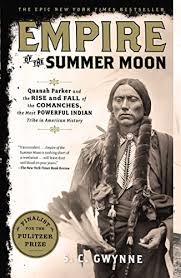Comanches & Popular History

S.C. Gwynne, a journalist who has written for Time, Texas Monthly, The Dallas Morning News and other publications, as well as authored several books, wrote Empire of the Summer Moon: Quanah Parker and the Rise and Fall of the Comanches, the Most Powerful Indian Tribe in American History in 2010. A best-seller, Empire was a Pulitzer Prize finalist and was optioned. It is now being made into a movie. The book contains several stories that are fascinating, compelling, and have “legs” as they say in the film industry. It draws people in over a long period of time – even if they pick it up knowing something about the subject.
My knowledge of Native American history is thin. I do know enough, however, to know that I cannot speak with real authority. I’m also very aware that working in the field can be very challenging on a host of levels, from sourcing to audience to genre. Historians can be contentious. Further, it is difficult, if not impossible, to write history without moral awareness and judgments. What can one do with the story of US expansion and the destruction of native American lives and culture? All that said, the histories and the stories of the frontier can be extraordinarily gripping.
S.G. Gwynne, I would wager, was cognizant of this and more when he tackled Empire. It appears to be thoroughly researched. Gwynne’s arguments, too, are more journalistic than historical. In other words, he looks more to the traditional “Who? What? Where? When? Why?” questions than issues of continuity and change, which often trouble historians. He does not care much about trying to unpack what is contingent and what is causal. The outcome – a very strong book – makes for engaging reading and perhaps something less than a long, fully developed argument.
What Gwynne does tell us about the Comanches, their role within that larger environment, and the US settlers and government to remove and/or control them, is fascinating. It’s a heroic and brutal history, with endurance, bravery, violence, murder, rape, torture and horror. The Comanches and other neighboring peoples fought to the death. There was no surrender. That kind of finality found its way to Spanish, Texan and American fighters, too, leading to a culture of courage and cruelty. The Comanches, however, seemed to do it better – and more effectively – than anyone else. Gwynne’s account of their horsemanship and battle techniques left me amazed. Life was extremely tough for everyone on the frontier.
Quanah Parker embodies those contradictions. The child of a Comanche leader and an Anglo woman who was captured as a child (as her family was slaughtered), Quanah was a brilliant military commander, a take-no-holds fighter, and eventually, after a full surrender, an effective spokesman for his people. He was also very popular with key white American figures. Gwynne works hard at making sense of Quanah’s world and the world of his mother. Everyone faced difficult choices and multiple constraints. At the same time, many also were able to carve paths for themselves that were truly extraordinary.
Read the book. Watch for the movie. And consider reading more widely and investigating more deeply similar scholarship. I think that I will – it’s extremely interesting.
David Potash